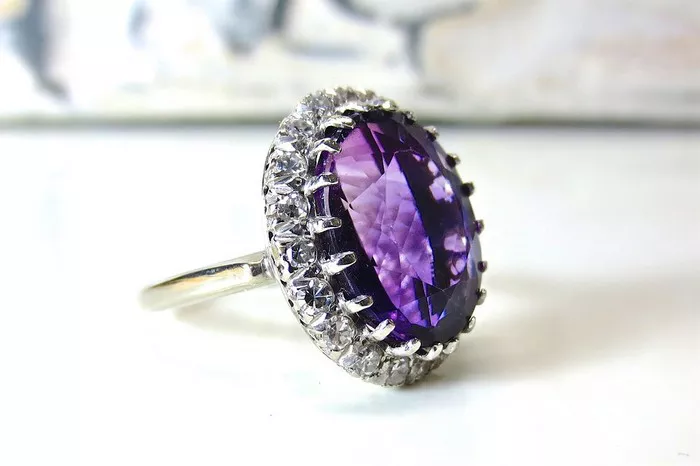Amethyst is a stunning gemstone known for its beautiful purple color and spiritual properties. As one of the most popular gemstones in the world, amethyst is often used in jewelry, including rings. However, with the increasing availability of synthetic and imitation gemstones, it can be challenging to determine whether an amethyst ring is real or not. In this article, we will discuss how to tell if an amethyst ring is real by examining various characteristics such as color, clarity, hardness, and authenticity markings.
Understanding Amethyst
Amethyst is a variety of quartz that ranges in color from pale lavender to deep purple. The color of amethyst is caused by trace amounts of iron within the crystal structure. Amethyst is prized for its rich purple hue, which can vary in intensity depending on factors such as location, clarity, and treatment.
Amethyst has been used in jewelry for centuries, and its popularity continues to grow today. In addition to its beauty, amethyst is believed to have various metaphysical properties, including promoting calmness, clarity, and spiritual growth. As a result, amethyst rings are not only fashionable but also carry symbolic and spiritual significance for many people.
How to Tell if an Amethyst Ring is Real
There are several methods you can use to determine whether an amethyst ring is real or not. Here are some tips to help you identify genuine amethyst:
Examine the Color: One of the most important characteristics of amethyst is its color. Genuine amethyst typically exhibits a rich, vibrant purple hue with excellent clarity. Be wary of amethyst rings that have a washed-out or uneven color, as this may indicate that the stone is not authentic. Additionally, real amethyst should not have any noticeable color zoning, which is the presence of distinct bands of color within the stone.
Check the Clarity: In addition to color, the clarity of the amethyst can also provide clues to its authenticity. Genuine amethyst often has few to no visible inclusions, or internal flaws, which can detract from its beauty and value. Hold the amethyst ring up to a light source and examine it closely for any imperfections or cloudiness. Authentic amethyst should have a clear and transparent appearance, with minimal to no visible inclusions.
Test the Hardness: Amethyst has a hardness of 7 on the Mohs scale, making it relatively durable and resistant to scratches. You can perform a simple scratch test to determine the hardness of the amethyst by attempting to scratch it with a material of known hardness, such as a steel file or another quartz crystal. If the amethyst is genuine, it should not be easily scratched or damaged.
Look for Authenticity Markings: Many genuine gemstones, including amethyst, are accompanied by authenticity markings such as stamps or engravings. Check the inside of the ring band for any markings indicating the type of metal used and the authenticity of the gemstone. Common authenticity markings for amethyst may include “925” for sterling silver or “14K” for gold.
Seek Professional Evaluation: If you’re still unsure about the authenticity of an amethyst ring, consider seeking a professional evaluation from a certified gemologist or jeweler. A gemologist can examine the amethyst using specialized equipment and techniques to determine its authenticity and provide you with a professional assessment.
Additional Considerations
In addition to the above methods, there are a few additional considerations to keep in mind when determining the authenticity of an amethyst ring:
Treatment: Some amethyst gemstones may undergo treatment to enhance their color or clarity. Common treatments for amethyst include heating and irradiation, which can alter the appearance of the stone. While treated amethyst can still be genuine, it’s essential to be aware of any treatments that may have been applied to the gemstone.
Origin: The origin of the amethyst can also affect its value and authenticity. Amethyst from certain locations, such as Brazil, Uruguay, and Zambia, is highly prized for its exceptional color and clarity. Be sure to inquire about the origin of the amethyst when purchasing a ring and consider obtaining a certificate of authenticity from a reputable gemological laboratory.
Price: As with any gemstone, the price of an amethyst ring can provide clues to its authenticity. Genuine amethyst is relatively affordable compared to other gemstones such as diamonds or emeralds. Be wary of amethyst rings that are priced significantly below market value, as this may indicate that the stone is not authentic or of poor quality.
Conclusion
Determining whether an amethyst ring is real involves examining various characteristics such as color, clarity, hardness, and authenticity markings. By following the tips outlined in this article and being vigilant when purchasing amethyst jewelry, you can ensure that you’re getting a genuine and high-quality piece that will bring you joy and beauty for years to come. Whether you’re buying an amethyst ring for yourself or as a gift for someone special, knowing how to identify real amethyst will help you make informed purchasing decisions and enjoy the timeless elegance of this stunning gemstone.


